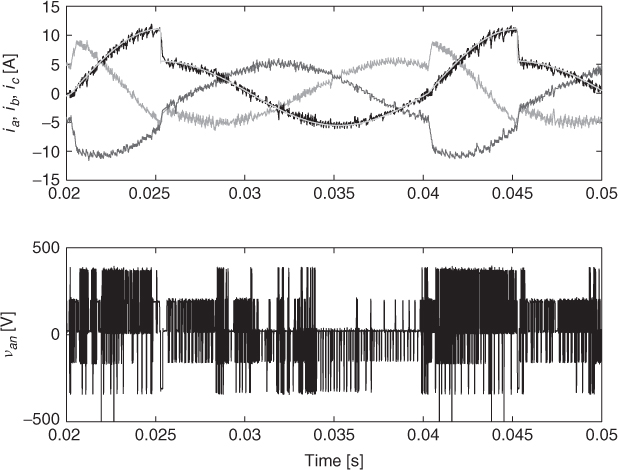4.9 Comparison to a Classical Control Scheme
A comparison of the predictive current control to classical control with PWM is presented in Figure 4.19a and Figure 4.19b. Here the amplitude of reference current ![]() is reduced from 13 to 5.2 A at instant t = 0.015 s while keeping the amplitude of current
is reduced from 13 to 5.2 A at instant t = 0.015 s while keeping the amplitude of current ![]() fixed. This is done to assess the decoupling capability of the current control loop. The load currents obtained using PI controllers with PWM, shown in Figure 4.19a, present noticeable coupling between iα and iβ and a slower response due to the dynamics of the closed current loops. The response of the predictive current control, for the same test, is shown in Figure 4.19b. Its dynamic response is fast with an inherent decoupling between both current components.
fixed. This is done to assess the decoupling capability of the current control loop. The load currents obtained using PI controllers with PWM, shown in Figure 4.19a, present noticeable coupling between iα and iβ and a slower response due to the dynamics of the closed current loops. The response of the predictive current control, for the same test, is shown in Figure 4.19b. Its dynamic response is fast with an inherent decoupling between both current components.
Figure 4.18 Experimental results for a step in the amplitude of the load current reference. Load currents and voltage in one phase

In addition to the reference tracking capabilities of any current control method, another important performance measure is the output voltage spectra generated by the inverter. The voltage spectra for the two control methods are compared in Figure 4.20.
Figure 4.19 Results for a step in the reference ...
Get Predictive Control of Power Converters and Electrical Drives now with the O’Reilly learning platform.
O’Reilly members experience books, live events, courses curated by job role, and more from O’Reilly and nearly 200 top publishers.

